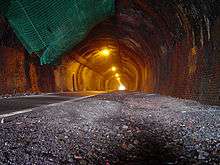Rail trail
A rail trail is the conversion of a disused railway track into a multi-use path, typically for walking, cycling and sometimes horse riding and snowmobiling. The characteristics of abandoned railways—flat, long, frequently running through historical areas—are appealing for various developments. The term sometimes also covers trails running alongside working railways; these are called "rails with trails". Some shared trails are segregated, with the segregation achieved with or without separation. Many rail trails are long-distance trails.
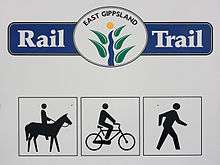
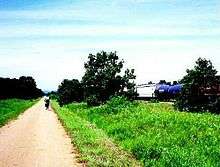
A rail trail may still include rails, such as light rail or streetcar. By virtue of their characteristic shape (long and flat), some shorter rail trails are known as greenways and linear parks.
Rail trails around the world
Americas
Bermuda
The Bermuda Railway ceased to operate as such when the only carrier to exist in Bermuda folded in 1948. Some of the former right of way were converted for automobile traffic, and in 1984 18 miles were converted to a rail trail, reserved for pedestrian use and bicycles on paved portions.[1] The rail bed spans the length of the island, and connected Hamilton to St. George's and several villages, though several bridges are derelict, causing the trail to be fragmented.
Canada
The Kettle Valley Rail Trail in British Columbia uses a rail corridor that was originally built for the now-abandoned Kettle Valley Railway. The trail was developed during the 1990s after the Canadian Pacific Railway abandoned train service.
The longest rail trail in Canada is the Newfoundland T'Railway that covers a distance of 883 km (549 mi)). Protected as a linear park under the provincial park system, the T'Railway consists of the railbed of the historic Newfoundland Railway as transferred from its most recent owner, Canadian National Railway, to the provincial government after rail service was abandoned on the island of Newfoundland in 1988. The rail corridor stretches from Channel-Port aux Basques in the west to St. John's in the east with branches to Stephenville, Lewisporte, Bonavista, Placentia and Carbonear.
Following the abandonment of the Prince Edward Island Railway in 1989, the government of Prince Edward Island purchased the right-of-way to the entire railway system. The Confederation Trail was developed as a tip-to-tip walking/cycling gravel rail trail which doubles as a monitored and groomed snowmobile trail during the winter months, operated by the PEI Snowmobile Association.
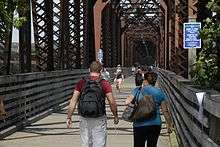
In Quebec, Le P'tit Train du Nord runs 200 km (120 mi) from Saint-Jérôme to Mont-Laurier.
In Toronto, there are two rail trails, the Beltline Trail and the West Toronto Railpath.
In central Ontario, the former Victoria Railway line, which runs 89 kilometres (55 mi) from the town of Lindsay, Ontario, north to the village of Haliburton, in Haliburton County, serves as a public recreation trail. It can be used for cross country skiing, walking, and snowmobiling in the winter months, and walking, cycling, and horse riding from spring to autumn. The majority of the rail trail passes through sparsely populated areas of the Canadian Shield, with historic trestle bridges crossing several rivers.
The old Sarnia Bridge in St. Marys, Ontario, was re-purposed as part of the Grand Trunk Trail. The former Grand Trunk Railway viaduct was purchased from Canadian National Railway in 1995. The Grand Trunk Trail was opened in 1998 with over 3 km (1.9 mi) of paved, accessible trail. In 2012, The re-purposing of the Sarnia Bridge was inducted into the North America Railway Hall of Fame.[2]
A railroad between Gateway Road and Raleigh Street in Winnipeg, Manitoba, was turned into a 7 km (4.3 mi) asphalt trail in 2007. It is called the Northeast Pioneers Greenway, and has plans for expansion into East St. Paul, and eventually to Birds Hill Park.[3]
In Nova Scotia, almost every section of the Trans Canada Trail and other walking trails are abandoned railways. A small railway line from Musquodoboit Harbour (Musquodoboit Trailway) to Dartmouth are nearly fully used by community members and tourists. Another extremely large section is used from Halifax to New Germany to Yarmouth to Grand Pre.
A considerable part of the Trans Canada Trail are repurposed defunct rail lines donated to provincial governments by CP and CN rail rebuilt as walking trails. The main section runs along the southern areas of Canada connecting most of Canada's major cities and most populous areas. There is also a long northern arm which runs through Alberta to Edmonton and then up through northern British Columbia to Yukon. The trail is multi-use and depending on the section may allow hikers, bicyclists, horseback riders, cross country skiers and snowmobilers.
United States
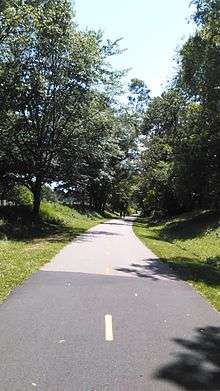
In North America, the decades-long consolidation of the rail industry led to the closure of a number of uneconomical branch lines and redundant mainlines. Some were maintained as short line railways, but many others were abandoned. The first abandoned rail corridor in the United States converted into a recreational trail was the Elroy-Sparta State Trail in Wisconsin, which opened in 1967. The following year the Illinois Prairie Path opened. The conversion of rails to trails hastened with the federal government passing legislation promoting the use of railbanking for abandoned railroad corridors in 1983 which was upheld by the U.S. Supreme Court in 1990.[4] This process preserves rail corridors for possible future rail use with interim use as a trail. By the 1970s, even main lines were being sold or abandoned. This was especially true when regional rail lines merged and streamlined their operations. As both the supply of potential trails increased and awareness of the possibilities rose, state governments, municipalities, conservation authorities, and private organizations bought the rail corridors to create, expand or link green spaces.
The longest developed rail trail is currently the 240 miles (390 km) Katy Trail in Missouri.[5] When complete, the Cowboy Trail in Nebraska will become the second longest, extending for 321 miles (517 km).[4][6] and the longest the Ohio to Erie Trail in Ohio at 326 miles (525 km)[7]
The Beltline, in Atlanta, Georgia, is currently under construction. In 2030, its anticipated year of completion, it will be one of the longest continuous trails. The Atlanta BeltLine is a sustainable redevelopment project that will provide a network of public parks, multi-use trails and transit along a historic 22-mile railroad corridor circling downtown and connecting many neighborhoods directly to each other.[8]
The Rails-to-Trails Conservancy is a nationwide nonprofit group that advocates for rail trails and has many documents and advice on building a rail trail. Per their records, the U.S. currently has 22,107 miles of rail trail complete. As of 2015, Michigan has the most total mileage (2,381) of any state.[9]
Europe
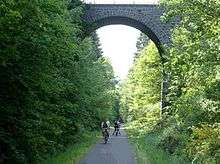
Germany
Germany has the largest number of rail trails in Europe,[10] with 677 rail trails with a total length of 5,020 kilometres (3,120 mi) (as at February 2015).[11] 80 more projects are being planned or under construction. Some of the longest rail trails are in the state of Rhineland-Palatinate. These are the Maare-Mosel-Radweg with 39 kilometres (24 mi) on the old rail track, the Ruwer-Hochwald-Radweg with 44 kilometres (27 mi) on the old rail track and the Schinderhannes-Radweg with 36 kilometres (22 mi) on the old track of the Hunsrück Railway.
United Kingdom
With almost 150 tracks in use, the United Kingdom has the second-largest network of rail trails in Europe after Germany.[10] The development of rail trails in the United Kingdom grew after a major programme of railway line closures in the 1960s known as the Beeching cuts. The scheme, named after Dr. Richard Beeching the then chairman of British Railways, decommissioned approximately 5,000 miles (8,000 km) of railway lines all over Great Britain. Many rural and suburban lines were closed along with selected main line trunk routes.[12] Since then, approximately 1,200–2,200 miles (1,900–3,500 km) of disused railway lines in Britain have been converted to public leisure purposes, and today the majority of rail trails are maintained by either the local authority or charitable organisations such as Sustrans, the Railway Ramblers or Railway Paths.[10]
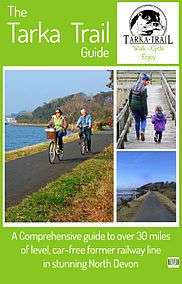
Many of these former railway lines form part of the British National Cycle Network, connecting with long-distance paths and towpaths along Britain's extensive network of canals. For example, the Milton Keynes redway system runs throughout Milton Keynes in Buckinghamshire, England, in parts using the former trackbed of the defunct Wolverton to Newport Pagnell Line (closed 1962) and the Grand Union Canal towpath. Together, these paths form part of the long-distance National Cycle Network Route 6 and Route 51. Other urban and suburban rail trails include the Fallowfield Loop Line in Manchester, the Middlewood Way in Cheshire and the Ebury Way in Watford. Notable rural rail trails include the Dava Way, running along the route of the former Highland Railway between Grantown and Forres in the Scottish Highlands, and the High Peak Trail in the English Peak District. In London, a more unusual scheme has been proposed to convert some disused London Underground tunnels into subterranean rail trails under the city, but this scheme has not been officially approved.[13]
Spain
With more than 2,500 kilometers of rail trails (Via Verde)[14] in a network of 117 cycling and walking itineraries, Spain ranks high in the European greenways scene. The trails are managed or coordinated by the Spanish Railways Foundation, and institution created in 1985. Many of the converted tracks were originally built for the mining industry, connecting remote mountain sites with port locations on the coast, now offering picturesque rides from wild interior landscapes to the seaside. [15]
Ireland
Cuts to Ireland's once expansive rail network in the mid 20th century left Ireland with a vast network of disused railways. While many lines were ripped up and the sections of the land acquired by private owners, a number of former railways do exist intact, thus providing the option for the development of many rail trails in the future.
The rail-trail on the former Westport to Achill Island line, known as the Great Western Greenway, was completed in 2011. Much progress has been made on the development of a rail-trail on the former Limerick to Tralee/Fenit line, in the form of the Great Southern Trail. As of 2013, a 36-kilometre (22 mi) section from Rathkeale to Abbeyfeale has been completed.[16]
Planning permission has been granted to redevelop the former Galway to Clifden railway into a greenway,[17] but negotiations are still underway with landowners regarding its routing.[18] A section of the Waterford, Limerick and Western Railway railway line, from Claremorris to Collooney has been touted for redevelopment as a greenway, but has met with some recent opposition from groups wishing for the redevelopment of the former railway itself.[19]
Belgium
The RAVeL network in Belgium combines converted tracks, byways and towpaths, adding up to a total of 1,200 km (750 mi) , a significant figure considering the size of the country. The gradient is never more than six per cent, and the tracks are open to all forms of non-motorised travellers, including cyclists, horse-riders, hikers and even roller-bladers.[20]
There is also the Vennbahn, which runs along an unusual border between Belgium and Germany.
Oceania
Australia
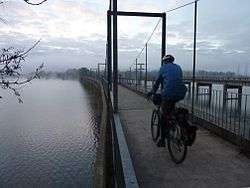
The development of rail trails in southeastern Australia can be traced to the gold rushes of the second half of the 19th century. Dozens of rail lines sprang up, aided by the overly enthusiastic "Octopus Act", but soon became unprofitable as the gold ran out, leading to a decreased demand for timber in turn. Decades later, these easements found a new use as tourist drawcards, once converted to rail trails. Dozens exist in some form, like the 37-kilometre (23 mi) Port Fairy to Warrnambool Rail Trail,[21] but only a few — such as the 95-kilometre (59 mi) Murray to the Mountains Rail Trail — have been fully developed. Progress is frequently hampered by trestle bridges in unsafe condition, easements that have been sold off to farmers, and lack of funds. Funding is typically contributed in roughly equal parts from federal, state, and local governments, with voluntary labour and in kind donations contributed by local groups.[22] The latest addition to the Rail Trail scene in Victoria is The Great Victorian Rail Trail which is the longest rail trail in Victoria covering 134 km (83 mi). It has become popular with tourists as it meanders through steep valleys and open farm country. The Rail Trails Australia website is a good source of local information. about trails in Australia.[23]
New Zealand
A number of rail trails have been established through New Zealand; the best known are the Hauraki Rail Trail (linking Thames, Paeroa, Te Aroha and Waikino/Waihi), Otago Central Rail Trail and the Little River Rail Trail. The New Zealand Cycle Trail project, a Government-led initiative, will greatly accelerate the establishment of new trails. The first seven projects (not all of them rail trails, though) were announced in July 2009 and will receive NZ$9 million in funding of the total project budget of NZ$50 million.[24]
Asia
Singapore
On 24 May 2010, the Singapore and Malaysia governments agreed[25] to move the Singapore terminus of the Keretapi Tanah Melayu Berhad (KTMB) from the Tanjong Pagar railway station in southern Singapore to Woodlands Train Checkpoint in northern Singapore. This resulted in the railway lines in Singapore becoming surplus as the Woodlands terminus is just over the border from Malaysia. Government agencies such as the Urban Redevelopment Authority (URA) and the Singapore Land Authority (SLA) have taken responsibility for developing and implementing ideas and activities for the former rail lands. The URA has a dedicated web site on Rail Corridor.[26] An example of activities permitted include Street Art on a section of the disused railway, supported by the SLA, URA, Land Transport Authority and the National Arts Council.[27]
The disused railway consists of the main line from the Tanjong Pagar railway station to Woodlands, extending either 24 km (15 mi)[28] or 26 km (16 mi)[29] , depending on the source. There is also the Jurong spur line, 14 km (8.7 mi) in length.[30] The area occupied by the railways is at least 80 ha (200 acres), and up to 173.7 ha (429 acres) when the land around the Tanjong Pagar Railway Station and other nodes are included.[30] Given the location of the railway lands in land scarce Singapore, there was concern that the lands would be developed. Organisations such as the Nature Society Singapore developed comprehensive plans to maintain the rail lands for nature-related pursuits.[30] The Green Corridor web site is a campaign website dedicated to preserving its natural form.
Urban rail trail parks
In a number of cities disused rail tracks have been converted into linear parks. One example is the High Line (also known as "High Line Park"), a 1.45-mile-long (2.33 km) elevated linear park created on an elevated section of a disused New York Central Railroad.[31] Inspired by the 3-mile-long (4.8 km) Promenade plantée (tree-lined walkway), a similar project in Paris completed in 1993, the High Line has been redesigned and planted as an aerial greenway and rails-to-trails park.[32][33]
Conversion issues
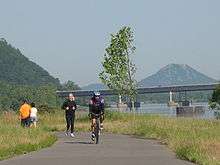
Rail trail conversions can be complex for legal, social, and economic reasons. Railroads in North America were often built with a mix of purchased land, government land grants, and easements. The land deeds can be over a hundred years old, land grants might be conditional upon continuous operation of the line, and easements may have expired, all expensive and difficult issues to determine at law.
Railroad property rights have often been poorly defined and sporadically enforced, with neighboring property owners intentionally or accidentally using land they do not own. Such encroachers often later oppose a rail to trail conversion. Even residents who are not encroaching on railway lands may oppose conversion on the grounds of increased traffic in the area and the possibility of a decline in personal security. Because linear corridors of land are only valuable if they are intact, special laws regulate the abandonment of a railroad corridor. In the United States, the Surface Transportation Board (STB) regulates railroads, and can allow a corridor to be "rail banked" or placed on hold for possible conversion back to active status when or if future need demands.
While many rail trails have been built, other proposals have been cancelled by community opposition. The stature of the conversion organization, community involvement, and government willingness are key factors.
On the other hand, there are a growing number of cases where existing rails and infrastructure, in service or not, are being called to be torn up for trails. Two cases of this are in New York State, against the Catskill Mountain Railroad in Kingston, New York,[34] and the Adirondack Scenic Railroad in Old Forge, New York.[35] In Connecticut, the not-in-service section of track on the Valley Railroad has been proposed by locals to be converted to trail.[36] Though perceived by residents to be, as it has not carried a train since the 1960s, the railroad has never been formally abandoned. The Connecticut Department of Energy and Environmental Protection acquired the line from Penn Central in 1969, and subsequently signed a long-term lease with the railroad. The railroad has been continually working to bring this section of the line back into service. Both Departments strongly support the preservation of the line, and have provided support to the railroad with property encroachment from abutters and the provision of railroad ties.[37] All three of these examples are heritage railroads, which serve to protect the history of the railroad. Their primary revenue is tourist operations, so rail traffic is seasonal; though all three have been granted rights to carry freight, should customers show interest.
Trails to rails
Though rare, there are several cases in which trails convert back to active railroads. One example occurred in 2012 in Clarence, Pennsylvania, where the R.J. Corman Railroad Company received permission to rebuild 20 miles (32 km) of railbanked line to serve new industries.[38] Conrail had ceased operating over the line in 1990, and 10 miles (16 km) was converted to the Snow Shoe Rails to Trails.[39]
Typical features
Most original rail lines were surveyed for ease of transport and gentle (often less than 2%) grades. Therefore, the rail trails that succeeded them are often fairly straight and ideally suited to overcome steep or awkward terrain such as hills, escarpments, rivers, swamps, etc. Rail trails often share space with linear utilities such as pipelines, electrical transmission wires, and telephone lines.
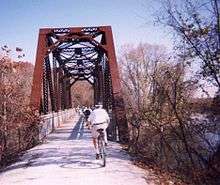
Most purchase of railway land is dictated by the free market value of the land, so that land in urban and industrial cores is often impractical to purchase and convert. Therefore, rail trails may end on the fringes of urban areas or near industrial areas and resume later, as discontinuous portions of the same rail line, separated by unaffordable or inappropriate land.
A railroad right-of-way (easement) width varies based on the terrain, with a 100 feet (30 m) width being ample enough where little surface grading is required.[40] The initial 705 miles (1,135 km) stretch of the Illinois Central Railroad is the most liberal in the world with a width of 200 feet (61 m) along the whole length of the line.[41] Rail trails are often graded and covered in gravel or crushed stone, although some are paved with asphalt and others are left as dirt. Where rail bridges are incorporated into the trail, the only alterations (if any) tend to be adding solid walking areas on top of ties or trestles, though bridges in poorer condition do receive new guardrails, paint, and reinforcement. If paved, they are especially suitable for people who use wheelchairs.
Where applicable, the same trails used in the summer for walking, jogging, and inline skating can be used in the winter for Nordic skiing, snowshoeing, and sometimes snowmobiling.
Railbanking
Railbanking is preserving railroad rights-of-way for possible future use. Railbanking leaves the tracks, bridges, and other infrastructure intact, relieving the railroad operating company from responsibility of maintenance and taxation. Often the tracks are put in custody of a state transportation agency, who then seeks a new operator for possible rehab or reactivation. This helps ensure the possibility of future restored rail service when new economic conditions may warrant resuming operation.
In the United States
In places with many environmental laws and other governmental regulations as the United States, it is very difficult to restore an abandoned line, but it is easier with a railbanked line than one that has undergone a "total abandonment", as the Federal government guarantees the railroad the full rights to reactivate it. A railbanked line can be reopened within a year's time while an abandoned corridor could take years to be reactivated, if it was even possible. In railbanking, the government helps fund the line's rebuild. 14,184 miles (22,827 km) of railroad have been abandoned in the 25-year period from 1983 to 2008.[42] Of that, 8,056.5 miles (12,965.7 km), representing 56.8% of the lines abandoned in the past 25 years, were originally negotiated for railbanking agreements.[42]
21% of those railbanking agreements failed; that is, they were ultimately abandoned. 5,079 miles (8,174 km) of those originally negotiated 8,056.5 miles (12,965.7 km) actually reached a railbanking agreement, representing 35.8% of the lines abandoned during the 25-year period.[42] The remaining 43.2% of the lines, representing 6,127.5 miles (9,861.3 km), were lines that railroads never considered trying to have railbanked, and were abandoned in their entirety. In total, 9,105 miles (14,653 km) of the 14,184 miles (22,827 km) abandoned during the 25-year period were not railbanked (64.2%).[42] Some railroads refuse to railbank lines, and instead sell the land in parcels to the surrounding landowners.[42]
Since railbanking began in 1983, nine railbanked corridors have been approved for reactivation by the STB. Some of these reactivated corridors had only short sections reactivated, while others had the entire corridor reactivated. Two of these approved have not yet been reopened, though both are in the process (as of March 2010).[43][44] Railbanked corridors are usually utilized as multi-use recreational trails for cyclists, walkers, joggers, snowmobiling, cross country skiing, and horseback riding.[42][43][44][45][46]
The land over which railways pass may have many owners—private, rail operator, or governmental—and, depending on the terms under which it was originally acquired, the type of operating rights may also vary. Without rail banking, on closure, some parts of a railway's route might otherwise revert to the former owner. The owner could reuse them for any purpose, or modify the ground conditions, potentially prejudicing the line's future reuse if required. However, the landowner must agree to keep the infrastructure such as bridges and tunnels intact.
Approximately 85% of the railroad rights-of-way in the United States[47] were acquired by easement from the then-abutting property owners. Normally, when the use for an easement is abandoned, the easement is extinguished and the land is not burdened by this adverse use. In 1983, Congress passed what is now known as the federal Rails-To-Trails law codified as 16 U.S.C. 1247(d). The federal law took the property rights of property owners throughout the United States for rail trails. Several property owners sued the government as the law took property without compensation. In 1990, the United States Supreme Court ruled that the property owners were entitled to compensation for the land taken for these rail trails.[48] In 1996, the plaintiff was awarded $1.5 million as compensation for the land taken for a trail through his property (see Preseault v. U.S., 100 F3d 1525, Fed. Cir. [1996]).
The state of Connecticut has taken a proactive approach to preserving railway right-of-ways. Since the 1970s, Connecticut Department of Transportation policy has been to acquire abandoned rail lines for preservation. This has contributed to the majority of railroad mileage in Connecticut to be publicly owned, between the state and Amtrak.[49] Today, this policy continues; the State will purchase any RoW that shows future potential for transportation, when the property becomes available.[37] CDOT has subsequently transferred 60 miles of RoW to the Connecticut Department of Energy and Environmental Protection for use in rail trails, and CDEEP itself has independently obtained another 50 miles (22 of which are used for the Valley Railroad). A provision of this transfer is that CDOT is allowed to retake ownership of a right-of-way when needed for transportation purposes.[37] Because of this, Connecticut is one of the only states where railbanked corridors have a reasonable chance of reactivation (should there be a need to), where elsewhere local opposition from trail users and property abutters would be able to directly influence a municipally-owned right-of-way.
Often, most of or all infrastructure is removed regardless to future use. Laws have been passed to remove infrastructure, in some case. For example, in the Commonwealth of Pennsylvania, a law was made to remove all unused railroad overpasses.[42] Another example is a natural disaster. If a flood washes away a railbanked railroad bridge, that is beyond the owner's control. The local, state, and Federal governments could give some financial help for the railroad to rebuild any infrastructure that may have been damaged or destroyed during the time that it was unused.[42]
A single section of a route changed in this way could have serious consequences for the viability of a restoration of a service, with the costs of repurchasing the land or right-of-way or of restoring the site to its former condition outweighing the economic benefit. Over the full length of a railway's route with manhttps://dcms-external.s3.amazonaws.com/MPD/62491/6DE4972C1FB0928C852580CF0068347E/45420.pdfhen it foreclosed on and sold three parcels of railbanked land where each spanned the full width of the right-of-way. [50] The county's sales of the parcels were preempted by federal law and were vacated to keep the rail line available for reactivation.[51]
By designating the route as railbanked, these complications are avoided and the costs of maintaining a right-of-way are removed from the railway operator. In the United States, land transferred to rail banks is held by the state or federal governments and many rail banks have been reused as rail trails.
In the United Kingdom
In the United Kingdom, thousands of miles (kilometers) of railway were closed under the Beeching Axe cuts in the 1960s and while several of these routes have subsequently been reopened, none were formally treated as land banks in the US manner. The Beeching closures were driven by the government's desire to reduce expenditure on railways, and so most lines were offered for sale to the highest bidder, a process which frequently led to great fragmentation in the ownership of former UK railway lines.
See also
- Bustitution
- Cycleway
- Greenway (landscape)
- Outline of cycling
- List of rail trails
- Rails-to-Trails Conservancy (RTC)
- Rails with trails (along a working line)
- Segregated cycle facilities
- Sustrans
- Marvin M. Brandt Revocable Trust v. United States
- EuroVelo, a network of long-distance cycling routes across Europe
Notes
- "Safeguarding Transport Routes & Protection of Disused Railway Trackbeds", Proposals for a Rail Bank, in Norfolk, England
- "Katy Bridge at Boonville: Withdrawals from the railbank", article on proposals to dismantle a bridge included in a Missouri Rail Bank
- Spencer, D. M. (2010). "Segmenting special interest visitors to a destination region based on the volume of their expenditures: an application to rail-trail users". Journal of Vacation Marketing. 16 (2): 83–95. doi:10.1177/1356766709357486.
- Moore, Roger L.; Graefe, Alan R. (1994). "Attachments to recreation settings: The case of rail‐trail users". Leisure Sciences. 16 (1): 17–31. doi:10.1080/01490409409513214.
- Troped, Philip J.; Saunders, Ruth P.; Pate, Russell R.; Reininger, Belinda; Ureda, John R.; Thompson, Shirley J. (2001). "Associations between Self-Reported and Objective Physical Environmental Factors and Use of a Community Rail-Trail". Preventive Medicine. 32 (2): 191–200. doi:10.1006/pmed.2000.0788. PMID 11162346.
- Merom, Dafna; Bauman, Adrian; Vita, Philip; Close, Glenn (2003). "An environmental intervention to promote walking and cycling—the impact of a newly constructed Rail Trail in Western Sydney". Preventive Medicine. 36 (2): 235–42. doi:10.1016/S0091-7435(02)00025-7. PMID 12590999.
- Betz, Carter J.; Bergstrom, John C.; Bowker, J. M. (2003). "A Contingent Trip Model for Estimating Rail-trail Demand". Journal of Environmental Planning and Management. 46 (1): 79–96. CiteSeerX 10.1.1.199.3385. doi:10.1080/713676704.
- Bowker, J.M.; Bergstrom, John C.; Gill, Joshua (2007). "Estimating the economic value and impacts of recreational trails: a case study of the Virginia Creeper Rail Trail". Tourism Economics. 13 (2): 241–60. doi:10.5367/000000007780823203.
- Bichis-Lupas, Mihaela; Moisey, R Neil (Fall 2001). "A Benefit Segmentation of Rail-Trail Users: Implications for Marketing by Local Communities". Journal of Park & Recreation Administration. 19 (3): 78–92.
- Siderelis, C.; Moore, R. L. (1995). "Outdoor recreation net benefits of rail-trails". Journal of Leisure Research. 27 (4): 344–59. doi:10.1080/00222216.1995.11949754.
- Wright, Danaya C. (2008). "The Shifting Sands of Property Rights, Federal Railroad Grants, and Economic History: Hash v. United States and the Threat to Rail-Trail Conversions". Environmental Law. 38: 711. SSRN 1317385.
References
- "Bermuda Railway Trail". Bermuda Dept. of Tourism. Retrieved December 14, 2008.
- "North America Railway Hall of Fame". narhf.org. Archived from the original on 2013-09-29. Retrieved 2015-05-15.
- "Northeast Pioneers Greenway | Winnipeg Trails Association". Winnipegtrails.ca. 2014-06-20. Retrieved 2016-08-18.
- "Archived copy". Archived from the original on 2013-10-21. Retrieved 2013-06-05.CS1 maint: archived copy as title (link)
- "Katy Trail mileage is 237.5 mile per railroad mileage markers". Mostateparks.com. Retrieved 2016-08-18.
However, per correspondence with Dawn Frederickson of Missouri State Parks (8/8/2014), the total trail mileage is 240 miles, taking into consideration trail deviations from the original railbed.
- http://www.bikecowboytrail.com/
- Withrow, Brandon. "The Best Cross-Country Road Trip Is on a Bike". thedailybeast.com. Daily Beast. Retrieved 2 October 2019.
- "ABOUT // Atlanta BeltLine". Beltline.org. 2014-06-20. Retrieved 2016-08-18.
- "United States | Rails-to-Trails Conservancy". Railstotrails.org. Retrieved 2016-08-18.
- Conlin, edited by Michael V.; Bird, Geoffrey R. (2014). "A Brief History of Rail Trail Development". Railway heritage and tourism : global perspectives. Bristol: Channel View Multi Matter. pp. 92–93. ISBN 9781845414382. Retrieved 7 February 2015.CS1 maint: extra text: authors list (link)
- Achim Bartoschek. "Bahntrassenradeln - Deutschland [Achim Bartoschek]". Bahntrassenradeln.de. Retrieved 2016-08-18.
- "Britain's most hated civil servant". BBC News. Retrieved 7 February 2015.
- O'Sullivan, Feargus. "Bike paths in abandoned tube tunnels: is the London Underline serious?". The Guardian. Retrieved 7 February 2015.
- "Map of the Spanish rail trails". Retrieved 4 March 2017.
- "Vias Verdes". Official website of the Rail Trails of Spain. Retrieved 4 March 2017.
- "Trail Information". SouthernTrail.net. Archived from the original on 7 April 2012. Retrieved 21 October 2013.
- "RTE News". rte.ie. Retrieved 21 October 2013.
- "Connemara greenway negotiations". connachttribune.ie. Archived from the original on 21 October 2013. Retrieved 21 October 2013.
- "Proposed Sligo-Mayo Greenway stalled over dispute and funding". Sligo Today News. Retrieved 21 October 2013.
- "RAVeL Network". Official website in English. Retrieved 4 March 2017.
- Port Fairy to Warrnambool Rail Trail, About us, accessed 5 June 2013
- "Rail Trails" (PDF). Rail Trails. Retrieved 2016-08-18.
- "Home".
- "PM turns first sod on cycleway project". The New Zealand Herald. Newstalk ZB. 10 November 2009. Retrieved 30 October 2011.
- "JOINT STATEMENT BY PRIME MINISTER LEE HSIEN LOONG AND PRIME MINISTER DATO' SRI MOHD NAJIB TUN ABDUL RAZAK AT THE SINGAPORE-MALAYSIA LEADERS' RETREAT ON 24 MAY 2010" (PDF). Habitatnews.nus.edu.sg. Retrieved 2016-08-18.
- "Archived copy". Archived from the original on 2015-05-12. Retrieved 2015-05-15.CS1 maint: archived copy as title (link)
- "LAND : MARCH 2014 Issue : brought to you by SLA". www.sla.gov.sg. Retrieved 2015-05-15.
- "About the Project". Ura.gov.sg. Retrieved 2016-08-18.
- "50 ways to the Singapore Rail Corridor — City Form Lab". Cityform.mit.edu. Retrieved 2016-08-18.
- "Archived copy" (PDF). Archived from the original (PDF) on 2015-11-23. Retrieved 2015-02-19.CS1 maint: archived copy as title (link)
- F. Green and C. Letsch (September 21, 2014). "New High Line section opens, extending the park to 34th St". Daily News. Archived from the original on September 21, 2014. Retrieved September 21, 2014.
- "Paris Elevated Rail Park Featured in Movie 'Before Sunset'". Friends of the High Line. August 12, 2004. Archived from the original on June 19, 2010. Retrieved July 27, 2014.
- "An elevated park à la française". Friends of the High Line. February 1, 2012. Archived from the original on February 5, 2012. Retrieved July 27, 2014.
- "Archived copy". Archived from the original on 2014-10-06. Retrieved 2014-09-30.CS1 maint: archived copy as title (link)
- "Rail trail for Adirondack Park a better idea for Old Forge to Saranac Lake corridor | Editorial". Poststar.com. 2013-08-07. Retrieved 2016-08-18.
- Hesselberg, Erik. "New Study Proposes Rail-Trail Along Haddam's Valley Railroad Line". Hartford Courant. Hartford Courant. Retrieved 30 September 2014.
- "Connecticut State Rail Plan 2012-2016" (PDF). ct.gov. Connecticut Department of Transportation. Retrieved 30 September 2014.
- White, Cliff (22 May 2012). "Railroad company gets OK to reclaim tracks; decision will eliminate half of Rails to Trails". Centre Daily Times. State College, Pennsylvania. Archived from the original on 28 February 2013. Retrieved 13 July 2020.
- "R. J. Corman Railroad Company/Pennsylvania Lines Inc.-Construction and Operation Exemption-in Clearfield County, PA". STB Decision Document 42047. Surface Transportation board. Retrieved 13 July 2020.
- Raymond, William Galt (1917). The Elements of Railroad Engineering. Chapman & Hall, Ltd. p. 310.
railroad width of Right of way -wikipedia.
- Ackerman, William K. (1890). Historical Sketch of the Illinois-Central Railroad: Together with a Brief Biographical Record of. Fergus Printing Company. p. 96.
railroad width of Right of way -wikipedia.
- Fowler, Marianne (July 8, 2009). "Review of federal railbanking: successes, statistics, and landowner impacts". American trails. Archived from the original on 2011-12-24. Retrieved 31 January 2011.
Testimony presented to the Surface Transportation Board July 8, 2009, on the 25th anniversary of Section 8(d) of the National Trails Systems Act, which created the federal railbanking program
- From the Surface Transportation Board. "Surface Transportation Board hearing on rail banking abandoned railroad trail corridors". Americantrails.org. Retrieved 31 January 2011.
- "Story of Railbanking" (PDF). Atfiles.org. Retrieved 31 January 2011.
- "Railbanking is the essential legal tool for preserving abandoned railroad rights of way for Trails and Greenways, planning, railtrail corridor study, recreation path system, l". Americantrails.org. 17 March 2007. Retrieved 31 January 2011.
- "Rails-to-Trails Conservancy:: What We Do:: Trail Advocacy:: Railbanking". Railstotrails.org. Retrieved 31 January 2011.
- "National Association of Reversionary Property Owners". Home.earthlink.net. Retrieved 2016-08-18.
- "Preseault v. ICC". Supreme.justia.com. Retrieved 31 January 2011.
- "2013 Connecticut Rail Transportation Ownership and Service" (PDF). ct.gov. Connecticut Department of Transportation. Retrieved 30 September 2014.
- Sunflower Rails-Trails Conservancy, Inc. - Petition for Declaratory Order - Sale of Railbanked Right-of-Way (PDF) (Report). Surface Transportation Board Decision Document 45420. 23 February 2017. Retrieved 13 July 2020.
- Sunflower Rails-Trails Conservancy, Inc. - Petition for Declaratory Order - Sale of Railbanked Right-of-Way (PDF) (Report). Surface Transportation Board Decision Document 46055. 17 October 2017. Retrieved 13 July 2020.
| Wikimedia Commons has media related to Rail trails. |
